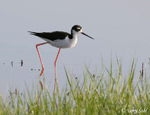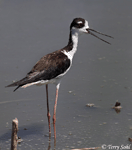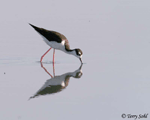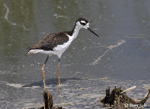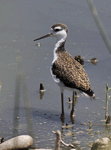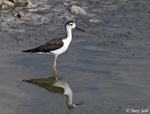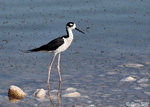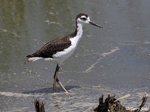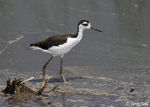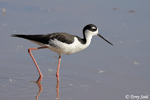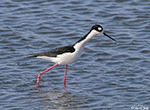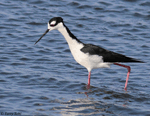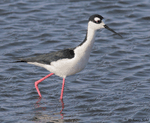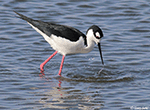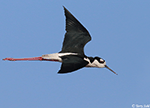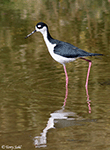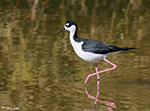Black-necked Stilt
Himantopus mexicanus
| Length: 14 to 15 inches | Wingspan: 26 inches | Seasonality: Migrant / Summer |
| ID Keys: Extremely long dark pink legs, black upperparts, white underparts, long needle-like bill. | ||
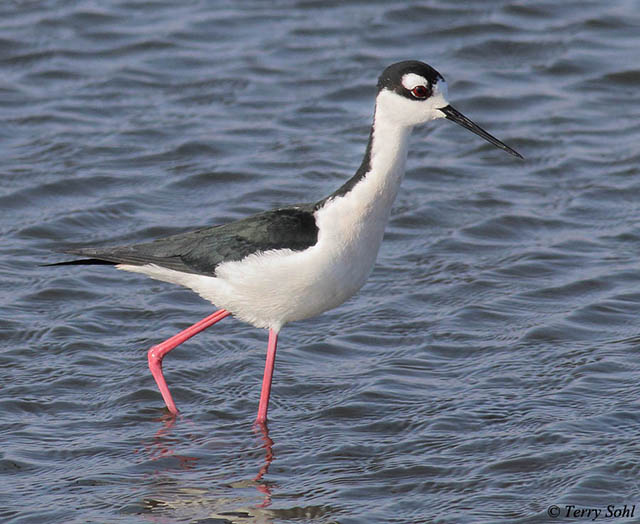 In relation to body size,
the Black-necked Stilt has some of the longest legs of any species of
bird. As with some other species of shorebirds, they may perform the
"wounded bird" display to lure potential predators away from nesting
sites. Black-necked Stilts have been quick to colonize artificial water
bodies which suit their breeding needs, and have been expanding in range and in
numbers in recent decades. They are still primarily uncommon migrants in
South Dakota.
In relation to body size,
the Black-necked Stilt has some of the longest legs of any species of
bird. As with some other species of shorebirds, they may perform the
"wounded bird" display to lure potential predators away from nesting
sites. Black-necked Stilts have been quick to colonize artificial water
bodies which suit their breeding needs, and have been expanding in range and in
numbers in recent decades. They are still primarily uncommon migrants in
South Dakota.
According to some classification systems, Black-necked Stilts are considered a Western Hemisphere subspecies of the broader "Black-winged Stilt" (Himantopus himantopus), which is found in every continent except for Antarctica. North American classifications systems, however, treat it as its own species.
Habitat:
Found in marshes, shallow expansive vegetated edges of ponds and lakes, and shallow bodies of water. Nests on open ground near water, preferably with very little vegetation.
Diet:
Primarily feeds on insects, insect larvae, crustaceans, and mollusks. Will occasionally feed on tadpoles, small frogs, and very small fish, as well as aquatic plant material.
Behavior:
Does most of its foraging by wading in shallow water and plucking food items from the water's surface, or by grabbing food items below the surface in shallow water. Will also forage on mudflats and shorelines.
Nesting:
June and July for their rare breeding attempts in South Dakota. The nest of a Black-necked Stilt is a shallow depression on the ground, lined with bits of grass, other vegetation, or shells and pebbles. The female lays between 3 and 5 eggs, and both parents help to incubate them. The young hatch after about 24 days.
Interactive eBird Map:
Click to access an interactive eBird map of Black-necked Stilt sightings
Song:
Loud pawwh or pleek often repeated for long periods of time.
- 1Click here to hear the short pleek calls of a Black-necked Stilt taking flight
- 2Click here to hear the alarm calls of several Black-necked Stilt
Migration:
Summers in widely scattered locations throughout the U.S. and extreme southern Canada. Winters near the Gulf Coast, the California coast, and southward.
Similar Species:
If seen well, Black-necked Stilts are unlike to be confused with another bird species, with their unique plumage and long-legged appearance. However, in less than ideal viewing conditions they could potentially be confused with the following:
- American Avocet - While both American Avocets and Black-necked Stilts share the same ridiculously long legs, size, plumage, and structural differences typically make differentiation between the two quite easy. American Avocets are larger, and appear more robust than the thin Black-necked Stilt. American Avocets also have a unique upcurved bill, while that of a Black-necked Stilt is straight. In breeding plumage, the two are easily differentiated, as American Avocets have a rich, warm brownish tone on their heads, neck, and upperparts. It's a non-breeding American Avocet that's most likely to be confused with a Black-necked Stilt, as they lose the rich warm tones and have a black-and-white pattern that could cause confusion. The ID keys above can help differentiate them, as can the white wing patch on a non-breeding American Avocet (Black-necked Avocets have purely black wings).
 |
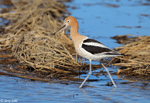 |
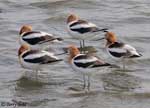 |
|
American Avocet (non-breeding) |
American Avocet (breeding) |
American Avocet (breeding) |
Status:
Black-necked Stilt numbers plummeted by the early 21st century, due to hunting pressures and habitat loss. However, they have been expanding in numbers and range in recent decades in North America, are found across a very broad geographic area, and are common in parts of that range. The IUCN considers the Black-necked Stilt to be a species of "Least Concern".
Further Information:
Photo Information:
July 27th, 2009 - Bear River Bird Refuge, Utah - Terry Sohl
Additional Photos:
Click on the image chips or text links below for additional, higher-resolution Black-necked Stilt photos.
Audio File Credits:
- 1Isain Contreras Rodriguez. Recorded in Sinaloa, Mexico on June 19th, 2020. Original recording and information available from xeno-canto.
- 2Steve Hampton. Recorded in Yolo County, California on June 5th, 2020. Original recording and information available from xeno-canto.
| Click on the map below for a higher-resolution view |
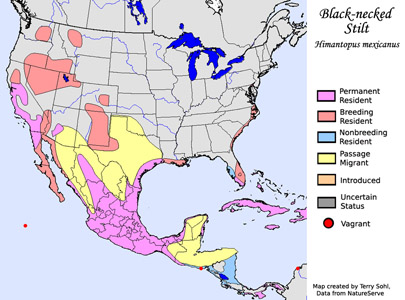 |
| South Dakota Status: Rare migrant. Rare summer breeder, with a handful of breeding records in the state. |
Additional Black-necked Stilt Photos
